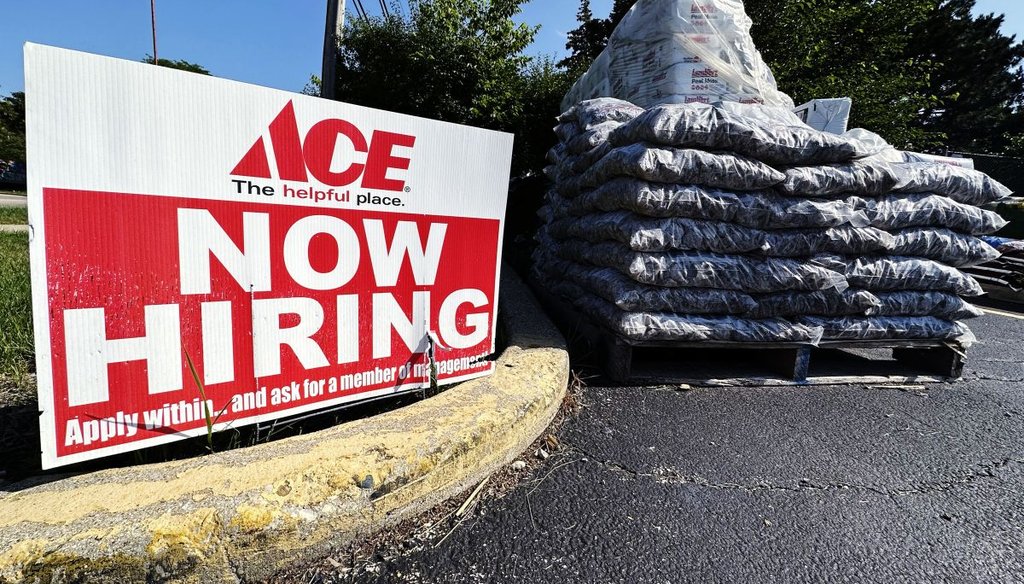Stand up for the facts!
Our only agenda is to publish the truth so you can be an informed participant in democracy.
We need your help.
I would like to contribute

A hiring sign outside of a hardware store in Buffalo Grove, Ill., on July 9, 2023. (AP)
If Your Time is short
-
The U.S. Bureau of Labor Statistics does not define people as “unemployed” unless they are actively looking for work.
-
In the bureau’s Employment Situation report for June, 5.4 million people did not qualify as unemployed because they were not actively looking for work. This includes students, retirees and people caring for family members.
-
This unemployment definition is not unique to the Biden administration; it’s been used for official government statistics since the 1940s.
As he prepares to run for another term in office, President Joe Biden has been touting a strong economy that’s rebounding from the effects of the COVID-19 pandemic. But a PolitiFact reader wondered whether the administration is misleading Americans about unemployment data.
PolitiFact is now publishing fact-checks in Spanish, and in July launched a WhatsApp number readers can use to text fact-check ideas. A reader recently messaged us a link to an article on The Gateway Pundit, headlined: "Gov’t admits millions of unemployed people were not counted in latest job stats."
The article on The Gateway Pundit site was written by The Western Journal, a conservative website. The article criticized a post by President Joe Biden on X, formerly Twitter, that boasts about a thriving economy.
The Western Journal article accused Biden of leaving out important information, saying that a U.S. Bureau of Labor Statistics report revealed "that more than five million Americans who are not working were not counted in the unemployment rate, which stands at 3.6 percent."
The bureau in its Employment Situation report for June said the unemployment rate was 3.6%. Elsewhere in that report, the agency said that there are 5.4 million Americans who are not reflected in that rate, because they are not officially considered unemployed.
"The number of persons not in the labor force who currently want a job was 5.4 million in June, little changed from the prior month," the report said. "These were not counted as unemployed because they were not actively looking for work during the 4 weeks preceding the survey or were unavailable to take a job." (The bureau published its July data a few days after The Western Journal published its article.)
It isn’t unusual or new for presidents to omit from their comments people who are not actively looking for a job. The bureau has used this definition since the 1940s.
Where the data comes from
The bureau’s unemployment numbers come from the Current Population Survey, a monthly, nationwide assessment. It has been conducted, under essentially the same parameters, every month since 1940, according to the bureau.
The government agency considers people employed if they did any paid work at all during the week the survey covers. The agency classifies people as "unemployed" if they do not have a job, are ready to take a job and have actively looked for a job in the four weeks preceding the survey.
Gary Burtless, economist and senior fellow at the Brookings Institution, a Washington, D.C.-based think tank, told PolitiFact that the bureau is not hiding these numbers.
"More than 5 million jobless workers who would like to find a job are not counted as ‘unemployed’ for a simple reason: They did not take any active steps to find a job in the four weeks preceding the labor market survey," Burtless said. "Most other rich countries use the same or a very similar definition of who is ‘unemployed.’"
The bureau also publishes monthly "alternative measures of labor underutilization" basis. These "alternative measures" include people who are "discouraged workers" (who are not looking for a job because they are too pessimistic about their chances of finding one) and "marginally attached" workers, who have looked for work recently, but not within the past four weeks.
The measurements with the broader definitions will show higher levels of "unemployment" than the most widely used rate. Burtless said the bureau publishes this array of estimates every month so economists can draw their own conclusions.
The numbers of unemployed Americans not looking for work "frequently attract public commentary, especially when the official unemployment rate is particularly high," Burtless said.
But now, Burtless said, the standard unemployment rate "is near a peacetime low, a fact that is very hard to contradict." And even the unemployment measurements that use the broader definition are low by historical standards.
The "U-6" measure — which uses the broadest definition of workers not currently employed, including those who are underemployed or have given up looking for work — was at 6.7% in July on a seasonally adjusted basis, compared with 3.5% for the standard rate the same month. Only during a few scattered months since the early 1990s has this measure been lower. (Seasonal adjustment is a statistical technique that tries to remove the influences of predictable seasonal patterns to show how employment and unemployment change from month to month.)
So, who are the people who are not working, but who aren’t "unemployed" by the bureau’s standards?
People going to school, retired or who have family responsibilities that keep them out of the labor force.
Our Sources
Post on X, July 29, 2023
The Western Journal, Gov't Admits Millions of Unemployed People Were Not Counted in Latest Job Stats, July 31, 2023
U.S. Bureau of Labor Statistics, How the Government Measures Unemployment, accessed Aug 2, 2023
U.S. Census Bureau, Current Population Survey Design and Methodology Technical Paper, accessed Aug. 2, 2023
U.S. Bureau of Labor Statistics, Databases, Tables & Calculators by Subject, accessed Aug. 2, 2023
U.S. Bureau of Labor Statistics, Alternative Measures of Labor Underutilization, accessed Aug. 2, 2023U.S. Bureau of Labor Statistics, THE EMPLOYMENT SITUATION -- JUNE 2023, accessed Aug. 4, 2023
U.S. Bureau of Labor Statistics, THE EMPLOYMENT SITUATION — JULY 2023, Aug. 4, 2023
Email interview with Gary Burtless, economist and senior fellow at the Brookings Institution, a Washington, D.C.-based think tank, Aug. 2, 202



























